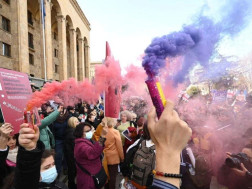Georgian Finance Minister Ivane Machavariani claimed that the sharp, leaping depreciation of the lari in recent days had been caused by protests launched by the opposition after the parliamentary elections.
"We declare with full responsibility that the depreciation of the lari stems from the radicalism that is taking place in the country," the Minister said.
According to him, there is no other objective reason for the GEL's depreciation at the moment.
The statement has raised a different viewpoint among economists and experts. BM.GE has looked at the archive of Georgian lari's exchange rate against USD during the largest mass protests and even revolution that has taken place in Georgia.
Exchange rate of lari during the 2003 Rose Revolution, which ended with the change of power in Georgia
The protests started on Nov 3 and ended on Nov 23. The cost of the GEL stood at US$ 2.1044 as of Nov 3, 2003. A week ahead, the rate was 2.1200. The exchange rate reached 2.2100 as of Nov 17, two weeks from the beginning of mass protests, and it reached 2.2200 on Nov 23. So, as the data shows, GEL has dropped by only 0.1156 towards US$.
Exchange rate of lari during anti-government protests of November 2007
November 2007 is frequently called the worst political crisis in Georgia in the past decade. Meanwhile, anti-government protests carried no impact over the exchange rate of lari, which during the whole of November 2007 stood at 1.6224 against US$.
Exchange rate of lari under mass rally against President Saakashvili in 2009
1 GEL was USD 1.6900 on April 9, on the first day of demonstration in Georgia. The rate was 1.6600 on Apr 16, GEL 1.6500 on Apr 24, GEL 1.6501 on May 01, and GEL 1.6400 on May 26.
So, as the archived data of GEL shows, street protests are the last to be blamed for the depreciation of the lari.
















